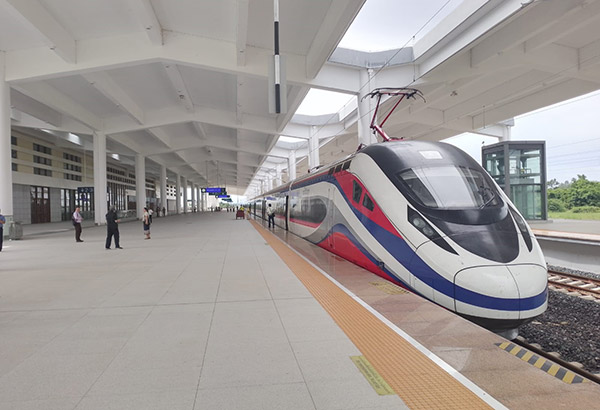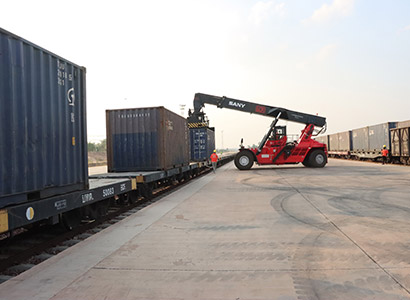BRI boosts Laos’ rail link ambitions through regional and global corridors
Beijing, China: China’s Belt and Road Initiative (BRI), instigated by Chinese President Xi Jinping, has achieved numerous fruitful results during its decade-long active and collaborative implementation, which involves more than 150 countries.
Alongside another 100 or so countries, Laos has reaped significant rewards from the scheme. The government is committed to capitalising on its landlocked position by becoming a land-linked country. Since the Laos-China and China-Laos railways became operational in 2021, the country has been able to integrate more closely with other countries in the region and beyond.
 |
| One of the trains that runs on the Laos-China and China-Laos railways. --Photo Phomphong Laoin |
In addition, the railway, which operates in a locally-oriented manner, is meeting the country’s increasing need for improved infrastructure and better public transport.
Director of the Operations and Management Department of China Railway International Co., Ltd., Mr Li Pu, one of the senior engineers involved in the construction of the China-Laos railway, recently shared his experiences with this Vientiane Times reporter in Beijing.
He said the China-Laos railway had made a big contribution to the socio-economic development of Laos since its inauguration in late 2021.
“Since the rail management sectors of China and Laos have actively implemented the important privileges after the opening ceremony, Chinese President Xi Jinping has advised the two sides to work closely and effectively in order to increase the volume of passengers, improve service quality, and make other positive contributions,” he said.
Mr Li said the railway plays a significant and important role in trade, investment and other forms of cooperation between China and Laos, and has brought the citizens of the two nations closer together.
“The Lao section of the railway has carried over 3 million passengers since the opening ceremony at the end of 2021. Most importantly, there is now a ticket office in the centre of Vientiane as well as a mobile ticket platform that was launched earlier this year to make it easier for passengers to buy tickets,” he added.
In terms of freight transport, operations have also grown robustly since the Chinese and Laos sections of the railway were formally connected. This has created a strong transport network as the railways are considered to be a strategic economic corridor between China and Asean.
In addition, the volume of cross-border trade has reached record levels through the provision of high quality and efficient services, which has reduced the time taken to ship freight as well as the costs involved.
“Cooperation in customs clearance between China and Laos has also improved significantly and the time involved has been gradually shortened. Notably, the railway interconnection will enable goods from landlocked Laos to extend further into international markets,” Mr Li said.
As well as transport and logistics benefits, the railway is creating job opportunities for several thousand Lao nationals, who have been recruited to assist at construction sites, and as train attendants and assistant drivers.
 |
 |
| A Lao troupe performs a typical traditional dance to celebrate the official interconnection between the China-Laos and Laos-China railways earlier this year. (File photo) |
A reachstacker loads containers at the Thanaleng Dry Port in Vientiane before transferring them to the cargo track for export via the railway. --Photo Tee Chee Seng |
“We are encouraging more Lao people to undergo training and learn professional skills at a specialised college in Laos. This is part of policy to ensure the railway continues to play an important role for the two countries and to create a community with a shared future, as well as demonstrate the appreciation between China and Laos through the railway,” Mr Li said.
The China-Laos Railway, also known as the “China-Laos International Railway Corridor”, is an electrified railway connecting Kunming in China’s Yunnan province to Vientiane, the capital city of Laos. It was built by China according to the China National Railway Class I standard.
The railway begins at Yuxi in the north and runs south to Mohan, the China-Laos border port, passing through Yuxi, Puer, Xishuangbanna prefecture and other cities, over a total distance of 508.53 kilometres and at speeds of up to 160 kilometres per hour.
It is a national railway Class I electrified railway. The Yuxi to Xishuangbanna section is a double line while the Xishuangbanna to Mohan section is a single line with a total investment cost of 50.545 billion yuan.
In the Chinese section, the main line Yumo Railway is 508.53km long.
Yumo Railway is owned by Kunmo Railway from Kunming in Yunnan province through Jinghong and Mohan in the same province. The railway is the Chinese section of the China-Laos Corridor, which connects to the Lao rail network at Boten in Laos.
After entering Laos at the Mohan/Boten station on the border of the two countries, the line extends southwest to Vientiane. The whole line complies with Chinese technical standards and equipment and covers a distance of 414 kilometres.
The rail-linked lines at the borders of China and Laos in the north will eventually pass through Vientiane and onwards to Thailand and Malaysia in the near future.
Observers say Laos is becoming integrated with the regional community in ways previously unimaginable since the government announced its intention to become a land-linked country.
The railway has enabled greatly enhanced international trade, investment and tourism thanks to the links it has created with other countries, which are delivering numerous benefits.
In October, China will mark the 10th anniversary of the Belt and Road Initiative (BRI) by organising the third Belt and Road Forum for International Cooperation (BRF) in Beijing.
It will have six themed forums, which will focus on trade connectivity, people-to-people connectivity, think tank exchanges, clean Silk Road, subnational cooperation and maritime cooperation.
The forum will also highlight the outstanding achievements over the past 10 years of BRI and to outline the future strategic plans in terms of political and economic cooperation projects.
The forum is a platform for working out action plans for implementation of the initiative in the areas of infrastructure, energy and resources, production capacity, trade and investment and identification of major projects.
The initiative has galvanised investment worth nearly US$1 trillion and established more than 3,000 cooperation projects over the past 10 years.
By the end of June, China had signed more than 200 BRI cooperation documents with 152 countries and 32 international organisations, according to a Chinese media.
Bounfaeng Phaymanivong, a journalist with Lao Press in Foreign Languages (Vientiane Times), is taking part in a four-month China Asia Pacific Press Centre 2023 Programme as one of more than 80 media personnel from almost 70 countries. The programme has been set up by the China Public Diplomacy Association under the supervision of the China International Press Communication Centre.
By Bounfaeng Phaymanivong
(Latest Update September 27, 2023)
|




